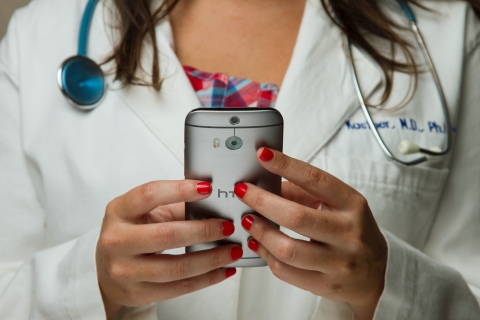

Telehealth has been an essential tool for providing health care to patients globally during the COVID-19 pandemic. Penn Medicine coordinated a multidisciplinary team from across the health system to design and implement an innovative telehealth platform that allowed an unprecedented increase in virtual appointments and has served hundreds of thousands of patients since early 2021.
Penn Medicine is an industry leader in telemedicine, having started one of the nation’s first teleICU programs more than a decade ago. Penn Medicine has two telemedicine divisions: the Center for Connected Care and Network Telemedicine.
The Center for Connected Care operates as a centralized telemedicine hub for the health system and houses the Penn Medicine OnDemand virtual urgent care program and the teleICU. Network Telemedicine supports Penn Medicine’s six hospitals and more than 200 outpatient practices in offering telemedicine from their sites.
Prior to the COVID-19 pandemic, Network Telemedicine supported fewer than 100 virtual visits per day on an integrated video platform that required clinicians to work from dedicated telemedicine workstations.
In the early days of the COVID-19 pandemic, it became clear that telemedicine tools would be essential to maintaining access to high quality care during the pandemic. People still needed to meet with their doctors, but with in-person gathering severely restricted, telemedicine appointments protected health care providers and patients from COVID-19 exposure, saved personal protective gear for providers doing in-person care, and even expanded access to care for people who could not easily travel to a doctor’s office.
The problem was that the legacy technology used for telemedicine appointments in doctor’s offices, clinics, and other ambulatory settings was outdated and difficult for patients and providers to use. Penn Medicine either had to buy new technology from an outside vendor, or develop their own platform in-house. Ultimately, it chose a blend of the two and created the Switchboard platform based on its extensive custom application infrastructure.
Incredibly, thanks to rapid collaboration among multiple teams, a process that would normally take months to implement—converting all Penn Medicine appointments from in-person to virtual—was accomplished in just one week.
Many Penn Medicine groups worked together to roll out the Switchboard telemedicine program. The Office of the Chief Medical Information Officer (CMIO), Information Services (IS)—especially the PennChart, Data Analytics Center, Application Development, and Predictive Health care teams—Electronic Health Record (EHR) Transformation, and the Center for Health Care Innovation (CHCI) were all intimately involved in this applied health informatics project.
Rather than having a stand-alone telemedicine system that providers had to link to manually from the electronic health record, the Switchboard team devised a web application that was seamlessly integrated into the electronic health record. Switchboard was designed to do the complicated work of pulling patient data from the health record, managing pre-visit reminders to patients as well as post-visit text message surveys, and integrating with a cloud-based video meeting platform where the patient and provider could meet, saving health care administrators and providers from managing this time-consuming work.
From the very beginning, Switchboard was designed to be easy to use for patients and providers. Switchboard sends patients a message—either by text message or email—with a link that takes patients directly into their secure meeting room.
Providers have access to the meeting room with just one click, and can quickly and securely access patient data on whatever device they are using. The platform even allows doctors to send a text message to a patient, for example, if the provider is running behind schedule. And the platform is easily adaptable—in one case, the team added new functionality that allows practice staff to send bulk automated messages to patients before and after visits to convey important information about the visit or ask survey questions.
Penn Medicine’s telehealth program has had unprecedented and unparalleled impact. In the first 11 months, six hospitals and more than 200 individual practices adopted Switchboard.
At least 8,800 clinicians received training and then conducted, at peak volume, an average of 30,000 telemedicine appointments per week, with 10,000 to 20,000 text messages exchanged between providers and patients every day.
Remarkably, the telehealth program and Switchboard platform allowed Penn Medicine to convert from an average of 75% of telehealth visits conducted by telephone to 75% conducted by video within a few weeks. Today, the platform still hosts about 2,000 telemedicine visits per day.
Even as the pandemic evolves and the medical necessity of telehealth visits subsides, telehealth is here to stay. Penn Medicine is finding new ways to employ this technology and recently-developed best practices in order to improve the patient and clinician experience. For surgical post-op visits, IR catheter and line checks, and many other health care needs, telehealth appointments save patients’ travel time, decrease wait time for appointments, and make more in-person appointments available for patients who cannot meet virtually with their health care team.
A core element of Penn Medicine’s applied health informatics work, telehealth will remain an important focus of the Center for Applied Health Informatics, with new initiatives developing as they are identified by Penn Medicine leadership, medical providers, and their patients.
